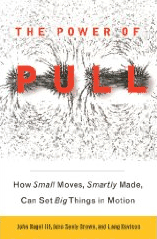Recently in Institutional Innovation Category
We are currently conducting research on social software for business performance and would love to hear your story. We invite you to participate in our call for cases by submitting your case here >>
The cases we develop will be highlighted in a publicly available, eminent research paper published later this year. Cases may also appear in some of our other publications (like our Harvard Business Review blog). All your information will be treated as highly confidential, and we will not share it without your approval.
N.B. - We define social software as collaborative tools used internally such as wikis, discussion boards, blogs, microblogs, idea trading/prediction markets and social networks that enable employees to communicate across boundaries, identify expertise, and access institutional memory. Using social tools for Social CRM and other marketing efforts externally is not in scope for this research.
Share your success stories with us >>
Here are some of the key, Power of Pull insights Braden Kelley picked up from our forum at the Biznik Innovators event:
- Don't focus on employee satisfaction. Often the most passionate people are the most frustrated. In the typical organization about 20% of the employees are passionate and 80% are not. This percentage is inversely correlated with corporation size. - JH
- "Extreme performance only comes from people who are passionate." - JSB
- Compactness Theorem - Kids need to link, then lurk, then join - JSB
- Spikes are places where you have a concentration of people focused on the same thing. When it comes to spikes in today's flat world, you can either go there, or try to pull them to you or pull them together. - JSB
- John Hagel told a story about Chris Anderson, Wired magazine editor and his side-project - Drone aircraft - and how he found a guy to be his CTO who knew more than anyone else about drone aircraft - only to find out he was a 19-year old high school dropout from Tijuana. He never would have found him via a traditional search.
- It would be helpful if we changed education system for the new world, but change can start without it - JH
- John Seely Brown talked about how construction contractors are actually good examples of 'pull' because of the underlying trust networks.
- The process of idea appropriation is very social and the best ideas do not always win. - JSB
- Our identities are shifting from consumption to creation. Who has used what you've created? What have you learned from it? - JH
- It used to be that what was important was 'What I own and control', but now 'I am what I build, share, and what others build on' - JSB
- Firms are focused on scalable efficiencies and need to switch to scalable learning. - JSB
- Handling exceptions is an opportunity for all employees to be creative - JSB
- Passionate people who leave organizations are incredibly important to innovation ecosystems. They often help start the next wave of innovation. - JSB
- 75% of business change initiatives fail. Most that succeed are threat-based. - JH
- Business relationships must create mutual value or they end quickly. - JSB
- You can't control serendipity but you can shape it. - JH
A second business model takes an equally contrarian approach to production. John Hagel and John Seely Brown, who run Deloitte's Centre for Edge Innovation, argue that Western companies have spent the past century perfecting "push" models of production that allocate resources to areas of expected demand. But in emerging markets, particularly those where the Chinese have a strong influence, a very different "pull" model often prevails, designed to help companies mobilise resources when the need arises. Hong Kong's Li & Fung or China's Chingquing Lifan Group can use their huge supply chains to produce fashion items or motorcycles in response to demand. Taiwan's Quanta and Compel can produce cheap computers and digital cameras for a fashion-conscious digital marketplace.
These pull models fundamentally change the nature of companies. Instead of fixed armies looking for opportunities, firms become loose networks that are forever reconfiguring themselves in response to a rapidly shifting landscape. Such models are not peculiar to emerging markets: Dell builds computers to its Western customers' specifications, and Western management gurus have been advocating networks for decades. But according to Messrs Hagel and Seely Brown they are far more widespread in emerging countries.

What can extreme surfing and World of Warcraft teach the enterprise? Independent Co-Chairman of the Deloitte Center for the Edge and former Xerox PARC Chief Scientist John Seely Brown holds them as examples of the power of frequent benchmarking and full industry info-share. He also uses them to show how the core ecosystem can be made stronger by sharing knowledge gathered from learning on the edge. In addition, Seely Brown touches upon his theory of a monumental economic shift from a push to a pull economy as outlaid in his 2010 book, The Power of Pull: How Small Moves, Smartly Made, Can Set Big Things in Motion.
More info >>
Today, our latest book--The Power of Pull: How Small Moves, Smartly Made, Can Set Big Things in Motion sees the light of day. Thanks to my co-authors JSB and Lang Davison!
Details >>

